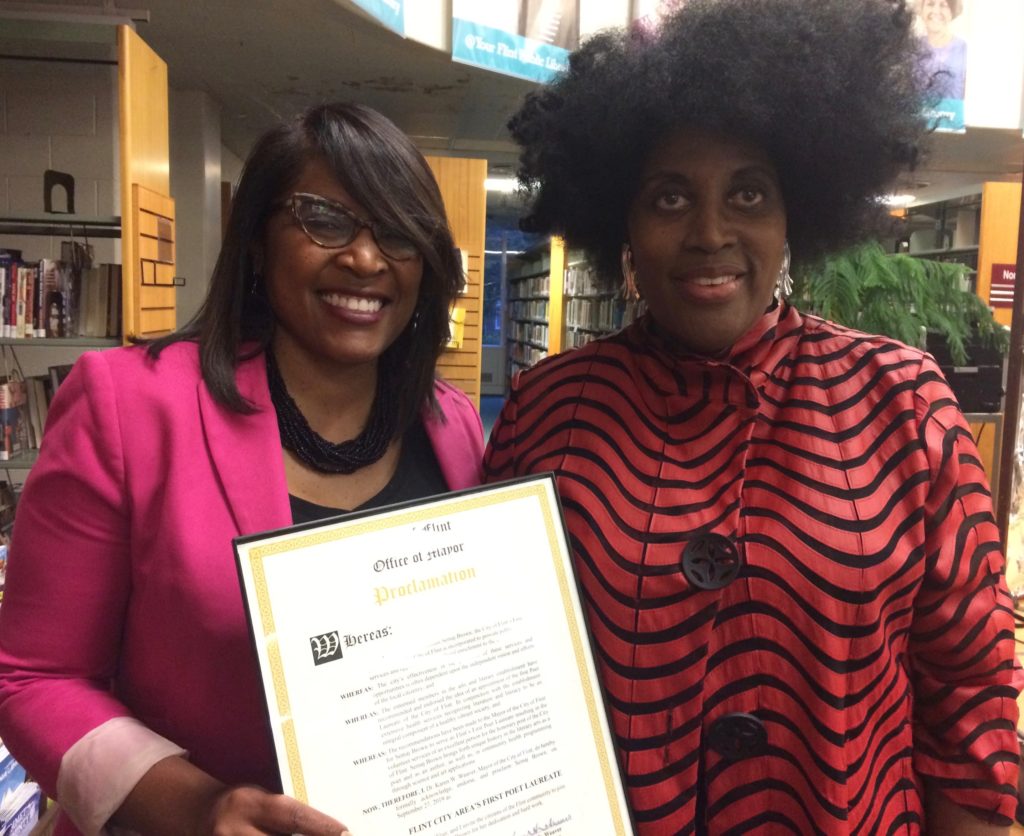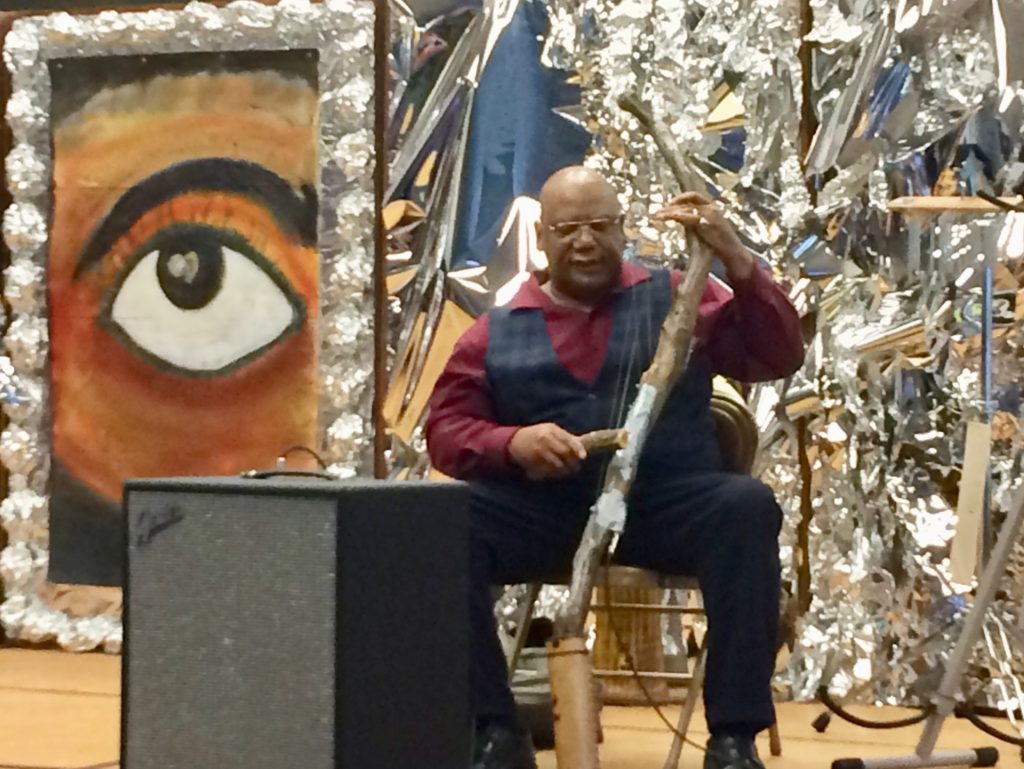
Pamela Pugh, City of Flint’s chief public health officer, presents a proclamation declaring Semaj Brown the city’s first poet laureate following a performance at the Flint Public Library (Photo by Jan Worth-Nelson)
By Jan Worth-Nelson
Semaj Brown, a poet, author, scientist, educator and artist, was named Flint’s first poet laureate Friday night by proclamation of Mayor Karen Weaver.
Brown, originally from Detroit, arrived in Flint in 2003 after marrying family physician James Brown and has since become a devoted community activist and much-beloved spoken word performer
What is a poet laureate? See below — Ed.
The honor was bestowed at the Flint Public Library in the mayor’s absence by Pamela Pugh, also a physician and the mayor’s chief public health advisor. The presentation, which seemed to come as a complete surprise, arrived after a “Poetry After Hours” library event.
Author of the 2019 book Bleeding Fire: Tap the Eternal Spring of Regenerative Light, Brown also has brought literacy combined with ebulliently good-natured and joyful advice on cooking, science and nutrition within her husband’s family medical practice and many other community initiatives.
Pugh said a number of community members had come to city officials asking them to create the volunteer position with Semaj specifically in mind as a fitting first recipient of the honor.
The proclamation read aloud by Pugh asserted “literature and literacy to be an integral component of a healthy, vibrant community” and noted Brown “brings her unique history as a poet, author, as well as in community health programming through science and art applications.”

Semaj Brown’s husband, Dr. James Brown, cites her “many gifts,” especially her gift of “education and inspiration” after she received the proclamation (Photo by Jan Worth-Nelson)
In 2010, Brown published the book Feasts and Fables from the Planted Kingdom, in which she offered vegetarian recipes and nutrition advice couched in the playful language of fables — the plants have names and personalities like “Lady Vidalia” and “Blanche Broccoli” and engage in schemes and little dramas.
An August EVM review of her recent appearance at the Mott-Warsh Gallery included the following account of her life and work:
Born in 1960, Brown is part of the “progeny” generation of the Broadside Lotus family [based in Detroit] emerging after the “legacy” poets of the 60s and 70s including Dudley Randall, Sonia Sanchez, Haki Madhubuti, Audre Lorde, Etheridge Knight and Gwendolyn Brooks
Further described on the cover as “Conversations in Poetry and Prose,” Brown’s idiosyncratic collection [Bleeding Fire] combines memoirs of her mother, the classical pianist and scholar Bessie L. James, along with dreams, recreated and transformed myths, commentary on the “Me-Too” movement, reflections on connections between science and art and more, offered up in six sections.
Brown has composed and often performs hard-hitting and riveting verse aimed at educating and empowering young women. An example is her poem R.O.A.R. [Rhymes of Applied Rights] in which she writes:
I am legitimate because I exist
I am valuable, the ancestors’ gift
I am worthy, a girl who will build
a better world for families
to live fulfilled
As noted in the August EVM review, Brown graduated from Wayne State with a degree in biology and taught science in the Detroit Public Schools, creating innovative science education curricula statewide and nationally.
“Science is my work; art is my work — I really don’t see the difference,” she said, asked to reflect on her omnivorous background and body of material. “It is all one–it’s all connected in my world.”
Brown’s husband also is a musician and composer, often joining her in her kinetic, wildly original performances. At the library performance he accompanied her on bongo drums and played an “arborlune” — a stringed instrument he literally made from backyard branches.

Dr. James Brown playing his homemade “arborlune” at the Flint Public Library. The “eye” painting in the background is by Ella Singer (Photo by Jan Worth-Nelson”
Brown said she is “humbled and grateful” by the honor and eager to serve the people of Flint in her new role.
“I can see all kinds of programming, all kinds of poetry, all kinds of word games, for how to bring the children in,” she said, “all part of creating a value system. There are so many things to be done if we can just LIFT–because we can, together.”
One poem she performed at the library performance was written for Karen Weaver on her recent birthday. Called “Fire Weaver,” it acknowledges the little-known history that some African slaves brought with them iron-working skills; Brown connected the fire required for that process to the auto-making industry in Flint–and Weaver’s leadership during the water crisis.
A separate set of plans are underway to bring Brown and her work to University of Michigan – Flint students through efforts of English Department faculty Erica Britt and department chair James Schirmer. More details are expected to be released soon about those events.
What is a poet laureate?
A poet laureate is a poet officially appointed by a governmental entity, usually in an honorary capacity, and often to acknowledge the community’s values of cultural enrichment, literature and literacy.
According to the website poets.org, “Of the 35 U. S. cities with populations of 500,000 residents or more, there are 16 with City Poets Laureate.” The site did not list cities the size of Flint having a poet laureate.
The U.S. has long history of naming poets laureate, including Tracy K Smith, Charles Wright, Nataha Trethewey, Philip Levine, W.S. Merwin and many more. The current U.S. poet laureate is Joy Harjo.
Many states have appointed poets laureate, though Michigan had one only once: Edgar Guest, from 1952 to 1959.
Typically poets laureates are expected or requested to develop literary programs and to compose poems for special events and occasions.
Banner photo: “Reflections” was the title of Semaj Brown’s FPL performance — she and her husband created this backdrop with “mirror fabric” and aluminum foil. “Eye” painting by Ella Singer.
EVM Editor Jan Worth-Nelson can be reached at janworth1118@gmail.com.



You must be logged in to post a comment.